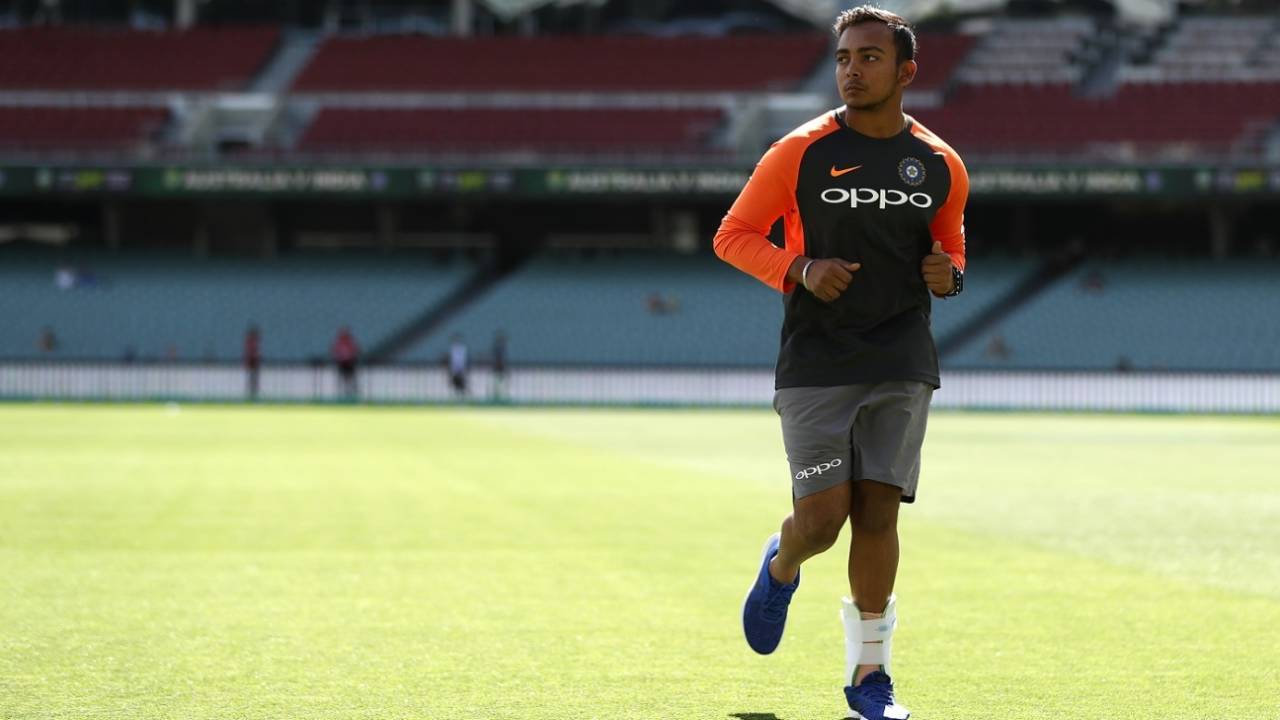Explainer: How the BCCI worked out Prithvi Shaw's suspension
Everything you need to know about the India Test opener's doping violation
Nagraj Gollapudi
30-Jul-2019
Prithvi Shaw tests out his injured ankle • Getty Images
The BCCI has suspended Test opener Prithvi Shaw for taking a banned substance called terbutaline in accordance with the World Anti-Doping Agency (WADA) code. The suspension is backdated from the day of the collection of the urine sample - February 22 this year - and will expire on November 15.
Let us look at how the BCCI arrived at the sanction and the various factors it took into consideration.
How did it start?
On February 22 this year, Shaw gave his urine sample as part of the BCCI's anti-doping rules (ADR) on the day of Mumbai's Syed Mushtaq Ali Trophy match against Punjab in Indore. The sample was collected by IDTM, an independent service provider, contracted by the BCCI. The sample was then sent to the WADA-accredited laboratory in New Delhi, where terbutaline was detected.
After an independent review, the board confirmed the finding and provisionally suspended Shaw on July 16. According to the final report prepared by Dr Abhijit Salvi, BCCI's anti-doping manager, two days later Shaw "waived his right" to have his B sample tested and accepted the charge.
How was the banned substance found in the urine sample?
In his reply to the BCCI, Shaw said he had taken an "over-the-counter cough syrup" which happened to contain terbutaline. Shaw also explained what led to him taking the cough syrup: having returned home from Australia with an ankle injury, he was anxious to get back on the field. He wanted to return to action in the 20-over Syed Mushtaq Ali tournament, which preceded the IPL. However, once he reached Indore, Shaw suffered a "common cough and cold".
According to Salvi's report , Shaw consulted his father, who "suggested that he visit a pharmacy to obtain a remedy for his symptoms". The pharmacist recommended the cough syrup in question, saying it "would provide immediate relief".
In his submission to the BCCI, Shaw said he did not "recall" the brand name of the cough syrup and didn't keep the bottle or the packaging. He used the medicine for "couple of days" before he played Mumbai's first match of the tournament on February 21, the day before the sample was taken by IDTM. In the form that was attached to the sample, to a question on whether he had taken any medication in the preceding week, Shaw wrote that he had taken "antibiotics".
Did the BCCI accept Shaw's explanation?
The BCCI accepted Shaw's reasoning that "it did not dawn upon him" that the cough syrup would contain a prohibited substance. "Irrespective of what Mr Shaw should have been thinking in respect of his use of medication, the BCCI accepts his assertion that he took the cough syrup merely to alleviate his symptoms, and not with the intent to enhance (or with the effect of enhancing) his sports performance," Salvi said in his report.

Prithvi Shaw ramps one for six•BCCI
What are the consequences of using a banned substance?
As per WADA rules, terbutaline is classified as a "specified substance" and carries a two-year ban as a "starting point". But under WADA rules, if it is established that the athlete had not been "negligent" and had consumed a medicine that contained a prohibited substance for "no significant fault" of his, the ban could be reduced on a sliding scale of 24 to zero months.
How did BCCI decide the length of the ban?
According to Salvi, he had to figure which of the three categories of "fault" he could slot Shaw's "inadvertent" action in: light (range of 0-8 months), normal (8-16 months) and considerable (16-24 months). This could only be decided after Salvi had established why and to what extent Shaw "departed from duty" of exercising "utmost caution" before he used the cough syrup.
Prima facie, Salvi mentioned in his report, that Shaw failed to fulfil the obligation of ensuring the cough syrup did not contain any prohibited substance. However, Salvi then pointed out that there were a few factors that favoured Shaw. Firstly, the player did not take the substance to enhance his performance and it was used for "therapeutic" reasons only. He also did not indulge in self-medication and relied on a medical professional's advice. Salvi also understood Shaw's anxiety of getting his "career back on track" after the injury in Australia, which might have prompted him to "overlook" the responsibility before taking an over-the-counter medicine.
Coupled with Shaw's age, 19, his limited anti-doping education and lack of experience, Salvi decided to classify Shaw under the normal category of fault and handed out an eight-month suspension.
Why is it backdated?
Under its anti-doping rules, the BCCI can utilise its discretion to adjust the sanction. Keeping in mind the fact that Shaw had not contested the charge at any point, the BCCI decided to backdate the ban from the date the urine sample was collected - February 22. However, the rules also dictate that Shaw needed to serve half the period of the ban, which is four months. The start date for that was set to July 16, when he was provisionally suspended. Consequently, Shaw is eligible to return to action from November 16 this year.
Nagraj Gollapudi is news editor at ESPNcricinfo
